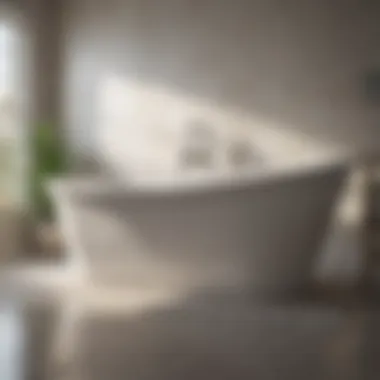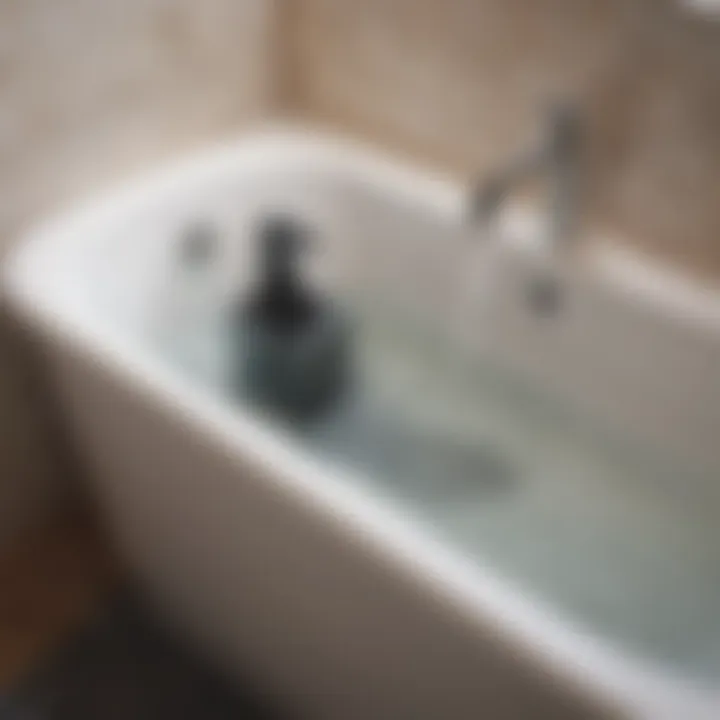Understanding and Resolving a Backed Up Bathtub


Intro
Dealing with a backed up bathtub can be more than just an inconvenience. It may signal deeper plumbing issues that need careful attention. Understanding the potential causes and symptoms is essential for any homeowner. Grasping the nuances of this problem will help in effectively addressing it before it escalates into a more severe issue.
In this guide, we aim to equip you with practical insights and solutions for a backed up bathtub. From straightforward preventive measures to more complex repairs, we offer a thorough analysis of the situation. By understanding the dynamics of how bathtubs function, any homeowner can take proactive steps to maintain their bathroom's functionality and comfort.
Understanding the Causes of a Backed Up Bathtub
A bathtub can become backed up due to various reasons. Here are some that are commonly observed:
- Hair buildup: Over time, hair can accumulate in the drain. This often combines with soap scum, creating a clog.
- Soap residue: Soap can leave behind residue that accumulates and traps additional material.
- Foreign objects: Items such as toys, cotton swabs, or other debris can inadvertently fall into the drain, leading to blockages.
- Tree roots: If you have older plumbing, roots from nearby trees can infiltrate pipes, causing significant backups.
Awareness of these key contributors will aid in diagnostic efforts.
Signs of a Backed Up Bathtub
Recognizing the signs of a backed up bathtub is crucial for timely intervention. Here are telltale indicators:
- Water drains slowly.
- Gurgling sounds from the drain.
- Foul odors emanating from the tub.
- Water pooling around the bathtub.
Any of these symptoms should prompt a closer inspection.
Effective Solutions for Bathtub Backups
Tackling a backed up bathtub can range from simple DIY solutions to calling a professional. Here are some methods to consider:
- Plunger: A plunger can often clear minor clogs. Ensure a tight seal around the drain.
- Drain Snake: If the clog is deeper, a drain snake can effectively break it up.
- Baking Soda and Vinegar: This natural solution can help dislodge buildups in pipes, often used as a preventive measure as well.
- Professional plumbing services: For persistent issues, hiring a professional plumber is advisable. They possess specialized tools and expertise to manage complex plumbing scenarios.
Consider these approaches carefully, ensuring to choose an option that fits the severity of the backup.
Preventive Measures
Preventing bathtub backups starts with regular maintenance. Here are some practical tips to keep your bathtub healthy:
- Install a hair catcher or drain screen to trap hair and debris.
- Regularly clean your drains with a mixture of baking soda and vinegar.
- Avoid flushing any inappropriate items down the drain.
- Schedule routine inspections by a plumbing professional.
By following these recommendations, you can enhance the longevity of your bathtub and reduce the likelihood of backups.
When to Call a Plumber
While many bathtub backups can be resolved independently, some scenarios require professional assistance. When you experience:
- Repeated clogs after attempts to resolve them.
- Backups in multiple drains, suggesting a more extensive plumbing issue.
- Significant plumbing damage, like leaks or cracks.
It is prudent to consult a licensed plumber. Their experience can save time and prevent further damage.
Ending
A backed up bathtub can disrupt everyday life. However, understanding the underlying causes, recognizing the signs, and knowing effective solutions gives you the power to manage the situation. By adopting preventive strategies and seeking professional help when needed, you can maintain a comfortable and functioning bathroom space.
Preface to Bathtub Backups
A backed up bathtub is more than just a nuisance; it can disrupt your entire bathroom experience. Understanding the issue at hand is essential for homeowners. This section provides foundational knowledge on what causes tub backups and why addressing them quickly is crucial. This understanding aids in smooth resolution, saving time and potential costs in repairs.
Defining a Backed Up Bathtub
A backed up bathtub occurs when water does not drain properly, leading to standing water. This situation can arise for various reasons, such as clogging or drains becoming obstructed. It is important for homeowners to recognize signs of backup to prevent further complications, such as water damage or plumbing issues.
Some common indicators of a backed up bathtub include:
- Inability of water to drain quickly.
- Frequent gurgling sounds during drainage.
- Odors emanating from the drain.
Understanding these signs is the first step in tackling the issue effectively.
Importance of Addressing the Issue
Addressing a backed up bathtub efficiently is imperative for several reasons. First, allowing a backup to persist can lead to more severe plumbing problems. Over time, stagnant water breeds mold and attracts pests. This can jeopardize the hygiene and comfort of your bathroom.
Second, timely intervention often leads to simpler resolutions. Many backups can be rectified through minor adjustments or DIY methods if approached early. By ignoring the problem, you may necessitate professional assistance, which can be costly.
"Addressing plumbing issues swiftly not only protects your health but also your home's value."
Common Causes of Bathtub Backups


Understanding the common causes of bathtub backups is crucial for effective maintenance and prevention. Identifying these causes helps homeowners to take proactive measures before the situation escalates. Each event leading to a backup can be unique, and by familiarizing oneself with these elements, one can better equip themselves to handle or prevent them. This section will delve into specific contributors to a backed-up bathtub, providing clear explanations for each.
Hair and Soap Buildup
One of the primary reasons bathtubs back up is due to hair and soap buildup. Hair that sheds naturally during bathing tends to accumulate in the drain. Combined with soap remnants, this forms a mass that obstructs water flow. Hair clogs can be particularly stubborn as they bind with soap residue, forming larger blockages over time. Regular cleaning is necessary to mitigate this issue. Homeowners should consider using drain covers or screens designed to catch hair and prevent it from going down the drain in the first place.
Foreign Objects in the Drain
Foreign objects can also lead to significant drain issues. Items such as children's toys, and personal items can fall into the tub and inadvertently end up in the drainage system. These objects often create immediate blockages that water cannot flow past. To avoid such situations, it's wise to create a habit of checking the tub area for items that might accidentally drop down. It's also advisable to educate children about keeping small objects away from the tub.
Tree Root Intrusion
Tree roots represent a less visible but serious cause of bathtub backups. As roots search for moisture, they often penetrate sewer lines, creating blockages. This type of issue is more common in homes situated near large trees. The problem may go unnoticed until a significant backup occurs. Homeowners should consider periodic assessments of their plumbing systems, especially if tree roots are nearby. Additionally, proactive landscaping can help in reducing this risk.
Disturbed Plumbing Lines
Disturbances to plumbing lines, including shifting soil or the natural settling of a home, can also lead to bathtub backups. Any movement can alter the path of pipes, leading to misalignments and potential blockages. Detecting such issues typically requires professional inspection because they often manifest as slow drainage or recurring backups. Homeowners should monitor such signs and respond with the appropriate level of scrutiny, considering the age and condition of their plumbing systems. It may be beneficial to schedule regular inspections to catch problems early before they become serious.
Signs of a Backed Up Bathtub
Recognizing the signs of a backed up bathtub is crucial for homeowners. Addressing these signs early can prevent more severe plumbing issues and costly repairs. Timely intervention can save not just money but also inconvenience and discomfort. Below, we explore some common indicators that indicate a potential backup in your faucet.
Slow Drainage
One of the first signs that your bathtub is backing up is slow drainage. If the water does not flow down the drain quickly like it once did, this could indicate a buildup of debris in the pipes. Hair, soap remnants, and other materials can accumulate and restrict water flow. Homeowners should take note if they experience even a slight delay in drainage.
Regular monitoring is essential. If you notice the water pooling around your feet while showering, it’s a clear signal that something is wrong. Ignoring slow drainage can lead to a complete blockage, which might require extensive repair work.
Unpleasant Odors
If your bathroom begins to emit unpleasant odors, this can point to a backed up bathtub. Such odors often arise from stagnant water caught in the pipes or a buildup of organic materials. This creates an environment for bacteria to thrive, which can lead to foul smells.
Homeowners should act promptly if there is a sudden increase in odor. Not only is it uncomfortable, but it also may indicate more serious plumbing issues. Keeping the bathtub clean and routinely checking for smells can prevent complications.
Gurgling Sounds
Another telltale sign of a bathtub backup is gurgling sounds when the water drains. These noises occur due to trapped air in the pipes as water struggles to flow past a blockage. The sound can sometimes be subtle, but its persistence should be a cause for concern.
If you hear gurgling consistently while draining your bathtub, you should investigate further. Ignoring this sign can lead to a more severe blockage and additional expenses to resolve the issue.
Backflow Issues
Backflow refers to the undesirable reversal of water flow in your drain system. If you notice wastewater bubbling up from your bathtub, this indicates a serious backup. Backflow issues are a direct result of clogged pipes or sewer line problems.
This situation can lead to unsanitary conditions in your bathroom. Homeowners should take immediate action if backflow occurs, as it could herald more severe plumbing failures.
Ignoring these signs can result in expensive repairs, unnecessary stress, and disruptions to daily life, making early detection key to managing bathtub backups.
Preventive Measures for Bathtub Backups
Preventing a backed up bathtub is crucial for maintaining proper functionality in the bathroom. The pain of dealing with backups and their consequences can lead to significant inconvenience and expense. By adopting preventive measures, homeowners can avoid the frustration associated with plumbing issues. Moreover, being proactive can save time, money, and energy in the long run as well as ensure that the bathroom remains an enjoyable space.
Regular Drain Cleaning
Regular drain cleaning should be an essential part of household maintenance. The process involves clearing out debris and buildup that can accumulate over time. Hair, soap residue, and even minerals from water can contribute to blockages. Homeowners can opt for various methods such as:
- Using boiling water to dissolve soap and grease.
- Employing commercial drain cleaners that break down organic material.
- Manual removal using gloves to fish out visible hair and debris.
By scheduling regular cleanings, ideally at least once a month, the risk of a clogged drain is reduced. This simple task can keep drains functioning well and prevent unpleasant surprises.
Using Drain Covers
Utilizing drain covers is a practical and effective way to reduce the volume of debris entering the drain. Drain covers act as a barrier that catches hair, food particles, and other foreign objects before they can enter the plumbing. Options include:
- Mesh drain covers, which prevent hair from escaping.
- Rubber mats, which can be easily cleaned.
The investment in drain covers is minimal compared to the costs associated with plumbing repairs. Regular cleaning of these covers is also imperative to ensure their effectiveness.
Proper Disposal of Waste
Understanding the proper disposal of waste is vital in preventing bathtub backups. Many items that are commonly flushed or sent down the drain can create significant clogs. Homeowners should educate themselves on what is acceptable for drain disposal. For example:
- Never flush items such as wipes, paper towels, or feminine products.
- Avoid rinsing food particles or grease down the drain, as they can solidify and lead to blockages.


Instead, consider using a garbage disposal for food scraps, and take non-flushable items to a trash can. By adopting these guidelines, one can greatly enhance the longevity of plumbing systems.
"Taking the time to prevent backups is always more beneficial than addressing them afterward."
DIY Solutions for Bathtub Backups
Understanding how to address a backed up bathtub with DIY solutions is valuable for homeowners. It can save both time and money. A backed up bathtub can disrupt daily life and cause frustration. Knowing how to handle simple problems allows for immediate action. This can prevent the issue from escalating or leading to costly repairs.
In this section, we look at some effective DIY methods. These methods include the plunger, drain snake, and the mixture of baking soda and vinegar. Each method has its own set of steps and benefits. They can be implemented easily with common household items.
Plunger Use
A plunger is often the first tool you should consider. It is designed for clearing clogs. The process is straightforward but requires a little technique for best results. Make sure the plunger is specifically made for sinks or bathtubs, as they have a different shape compared to toilet plungers.
- Preparation: Before you start, remove any visible debris in the tub. Ensure there's enough water to cover the bottom of the plunger cup.
- Placement: Position the plunger over the drain opening. Create a tight seal. This helps direct pressure to the clog.
- Action: Push down forcefully and pull up. Repeat this motion several times. The goal is to create a vacuum that loosens and dislodges the blockage.
- Check Results: After several attempts, remove the plunger and observe the drainage. If the water begins to drain properly, you have likely cleared the clog.
If the plunger does not resolve the issue, you might try the next method.
Drain Snake Techniques
If plunging does not work, a drain snake can be the next step. A drain snake is a long, flexible tool that can reach farther into the drain and grab or break up the obstruction. Using one requires careful handling, but can effectively deal with tougher clogs.
To use a drain snake, follow these steps:
- Inserting the Snake: Feed the end of the drain snake into the drain. Push gently, allowing it to navigate bends in the pipes.
- Finding the Clog: Once you feel resistance, you have likely reached the clog. Turn the handle to have the snake grip the blockage.
- Removing the Clog: Pull the snake back out carefully. If you successfully hooked onto the clog, it should pull out with it, or break it apart.
- Cleaning Up: Clear any debris from the snake and clean the drain area to avoid mess.
This method is efficient for hair and soap buildup, which often cause stubborn clogs.
Baking Soda and Vinegar Cleansing
This method serves as both a preventative and remedial solution. Mixing baking soda and vinegar creates a natural cleanser that can dissolve blockages.
To apply this technique:
- Preparation: Start by removing any standing water in the bathtub to expose the drain.
- Adding Baking Soda: Pour about half a cup of baking soda directly into the drain.
- Follow with Vinegar: Next, pour half a cup of white vinegar down the drain.
- Wait: Allow the mixture to sit for about 30 minutes. This waiting period enables the chemical reaction to occur, which can help break down the clog.
- Flush with Hot Water: After waiting, boil some water and pour it down the drain to help flush out any remaining debris.
Using this method occasionally can help keep drains free and clear.
When to Call a Professional
Recognizing when to call a professional for a backed up bathtub is crucial. Some situations can be managed with DIY methods, while others require the expertise of a plumber. Knowing the difference can save you time, money, and potential damage to your plumbing system. Plumbers bring specialized tools and experienced knowledge that most homeowners do not have. This ensures that repairs are executed correctly, minimizing chances of recurring issues in the future.
Evaluating Severity of Backup
To effectively determine whether professional intervention is necessary, evaluating the severity of the bathtub backup is essential. Consider the following points:
- Duration: If the backup has persisted for more than a day, it signals that a deeper issue may be at play.
- Drainage Rate: Slow drainage can often be a simple clog, but if your bathtub does not drain at all, a more serious blockage could be present.
- Multiple Fixtures Affected: If other plumbing fixtures in your home are also malfunctioning, this suggests a larger plumbing issue that requires a professional.
Using these criteria can help you assess whether the matter is urgent or if it can be temporarily managed.
Signs of Major Plumbing Issues
There are warning signs that a backup could indicate serious plumbing problems. Homeowners should be vigilant for:
- Frequent Backups: Regular occurrences of backups often point to ongoing issues in the plumbing system rather than isolated incidents.
- Visible Silt or Debris: If you notice silt or unusual debris near the drain or in the tub, this may indicate deteriorating pipes or a significant clog.
- Draining Sounds or Fluctuations: Strange gurgling or sounds when draining might suggest air blocks or other complications, requiring professional evaluation.
If you notice any of these signs, contacting a plumber is advisable. Ignoring them can lead to further damage and costly repairs.
Cost Considerations for Professional Help
Understanding the financial aspects of dealing with a backed up bathtub is crucial for homeowners. It helps to manage expectations and prepare for necessary expenses. Engaging a professional plumber can be a considerable investment, but it is often a worthy choice. Recognizing when to seek expert assistance, along with the costs associated with it, can make a significant difference in efficiently resolving plumbing issues.
Average Plumber Fees
The fees for plumber services can vary significantly based on several factors. Generally, the hourly rates for plumbers range from $45 to $200, depending on your location and the plumber's expertise. In most cases, a simple service call may cost between $75 and $150. If the issue is complex, like major clogs or pipe replacements, costs can rise considerably.
It is essential to ask for estimates before work begins. This ensures transparency regarding the anticipated expenses. Note that some plumbers may charge additional fees for materials or emergency service during odd hours.
Factors Influencing Costs
Several variables impact the cost of hiring a plumber:


- Location: Urban areas often have higher rates due to increased demand for services.
- Type of Service: Emergency services typically cost more than regular appointments. Simple repairs may come at a lower rate, while complex plumbing work will increase the overall bill.
- Experience of the Plumber: More experienced plumbers may charge higher rates but may also provide quicker and more efficient service.
- Time of Day: After-hours work often incurs additional fees.
- Extent of the Work Required: If extensive repairs or replacements are necessary, this could significantly raise costs.
"Knowing the cost factors is essential for proactive home maintenance, saving both time and money in the long run."
Understanding these cost considerations helps homeowners to make informed decisions. It leads to better financial planning and ensures efficient resolution of plumbing issues.
Maintaining a Functional Bathtub
Maintaining a functional bathtub is essential not just for comfort, but also for ensuring long-term usage and hygiene. By taking proactive measures, homeowners can minimize the risk of backups and preserve the integrity of their plumbing systems. A well-maintained bathtub can enhance the overall aesthetic of a bathroom, adding to the property value. Neglected bathtubs lead to problems that extend beyond mere inconvenience; they can cause costly repairs and structural issues.
Routine Inspections
Routine inspections of your bathtub and its surrounding areas allow for early detection of potential problems. Checking for leaks, cracks, or loose fittings can save you time and money. Regular inspections help monitor the condition of plumbing fixtures and ensure they are functioning well. Here are some specific elements to consider:
- Visual Checks: Look for visible signs of wear, such as rust, mold, or discoloration.
- Water Pressure: Check if water flows freely from the faucet, indicating a clear pipe.
- Drain Functionality: Ensure the drainage system works properly by observing if the water drains quickly after use.
By conducting these inspections on a quarterly basis, you can catch issues before they escalate, avoiding more significant expenses down the line.
Effective Cleaning Products
Using effective cleaning products can greatly impact the cleanliness of your bathtub and its longevity. Many products can help remove soap scum, hard water stains, and mold. When selecting cleaning agents, consider the following:
- Natural Ingredients: Look for products containing natural components, such as vinegar or baking soda, to minimize chemical exposure.
- Non-Abrasive Options: Choose non-abrasive cleaners to avoid damaging the surface of the bathtub.
- Specific Formulations: Consider cleaners specifically designed for the material of your bathtub, be it acrylic, porcelain, or fiberglass.
The right cleaning products not only keep your bathtub looking its best but also contribute to a healthy environment by reducing harmful bacteria buildup. Regular application of these products can maintain functionality and prolong the life of your bathtub.
"Regular maintenance is key to ensuring your bathtub remains a source of relaxation rather than a persistent problem."
Environmental Considerations
Addressing the issue of a backed up bathtub requires an understanding not just of the plumbing involved, but also of the environmental implications of our cleaning methods and maintenance practices. The significance of environmental considerations lies in their impact on water conservation, the use of harsh chemicals, and the overall sustainability of plumbing practices. It is essential to adopt approaches that not only resolve immediate issues but also contribute to the long-term health of our ecosystems.
Eco-Friendly Cleaning Solutions
When dealing with backups, traditional cleaning products often contain strong chemicals that can harm the environment. Eco-friendly cleaning solutions gain importance as sustainable alternatives that effectively tackle clogs while minimizing ecological damage. One such option is the use of natural ingredients, like baking soda and vinegar, which can break down organic matter and eliminate odors. This method is not only effective but also reduces the quantity of harmful runoff entering our waterways.
Additionally, several eco-friendly commercial products are available. These options typically avoid toxic fragrances and phosphates, making them better for both the environment and human health. It is crucial to choose products labeled as biodegradable or nontoxic, ensuring that they will not contribute to pollution in drains or threaten aquatic life.
Sustainable Plumbing Practices
The choice of plumbing practices can influence environmental health significantly. There are several sustainable practices homeowners can adopt to enhance their plumbing systems while protecting the planet. First, regular inspections and maintenance can extend the life of plumbing materials, reducing waste and minimizing the need for replacements.
Second, opting for low-flow fixtures can considerably reduce water consumption without sacrificing performance. Installing devices like aerators on faucets and showerheads can create a significant reduction in water usage. Introducing these measures presents an opportunity to contribute positively to conservation efforts.
Moreover, understanding the importance of proper drain disposal cannot be overstated. Avoid flushing non-biodegradable items or harsh chemicals down the drain, as this can lead to blockages and water contamination. Educating every household member about correct disposal habits helps in maintaining plumbing systems while supporting environmental sustainability.
By integrating eco-friendly cleaning solutions and sustainable plumbing practices, homeowners not only resolve issues but also play an active role in preserving the environment.
In summary, understanding the environmental considerations involved in maintaining a functional bathtub enhances the overall effectiveness of the solutions presented in this guide. Through conscientious cleaning choices and sustainable plumbing practices, we can ensure that our homes are not merely comfortable but also contributing to the longevity of our planet.
Finale
The conclusion of this comprehensive guide is vital for grasping the significance of proactive and informed approaches to bathtub maintenance. A backed up bathtub is more than just an inconvenience; it can lead to extensive damage and increased repair costs if not promptly addressed. Understanding the common causes, recognizing signs, and implementing preventive measures are critical steps for every homeowner.
In this article, we highlighted the importance of taking immediate action when experiencing drainage issues. Bathtub care requires consistent attention and awareness. Ignoring minor problems can escalate them into more severe plumbing issues, which may necessitate professional intervention. Thus, an informed homeowner should prioritize regular maintenance routines, including cleaning and inspections, as they can simplify the overall management of bathroom facilities.
"Awareness and action are key components in maintaining a functional and pleasant bathing space."
Additionally, being aware of eco-friendly practices when cleaning or repairing plumbing extends the benefits to the environment and promotes overall sustainability in the household. This dual focus on functional efficiency and environmental respect benefits both the homeowner and the community.
Ultimately, consistent upkeep can enhance the bathtub's performance, prolong its lifespan, and maintain the integrity of the home's plumbing system, providing a continuous source of comfort and functionality.
Final Thoughts on Bathtub Care
Caring for a bathtub involves more than regular cleanings and repairs; it represents a broader commitment to home maintenance. Homeowners should appreciate the advantages of investing a minimal amount of time and effort into their bathroom's upkeep.
Adopting simple habits such as using drain covers and disposing of waste properly can significantly reduce the likelihood of backups. Responsiveness to warning signs, like slow drainage or unusual noises, is paramount in minimizing potential damage.
A bathtub serves as a personal retreat, and maintaining it can greatly enhance both aesthetics and enjoyment. Knowledge gained from understanding the possible complications encourages a proactive mindset. This approach aids in promoting a more harmonious relationship with one's home.
Encouragement for Ongoing Maintenance
Ongoing maintenance is crucial. It is all too easy to overlook the routine checkups that help ensure everything operates smoothly. Homeowners should allocate specific times for inspections and cleaning to create a structured schedule.
Engaging in regular drain cleaning, at least once a month, can prevent buildup from hair and soap residue. Investing in quality drain covers can be an effective method to catch debris before it causes a blockage.
Furthermore, using non-toxic and environmentally friendly cleaning products supports both health and sustainability. This aligns with broader ecological goals in home maintenance, which benefits current and future generations.
Encouragement should be given not just for acting on issues as they arise but also for adopting a preventive philosophy towards bathtub care. A consistent commitment to maintenance results in a functional and pleasant bathroom environment.







